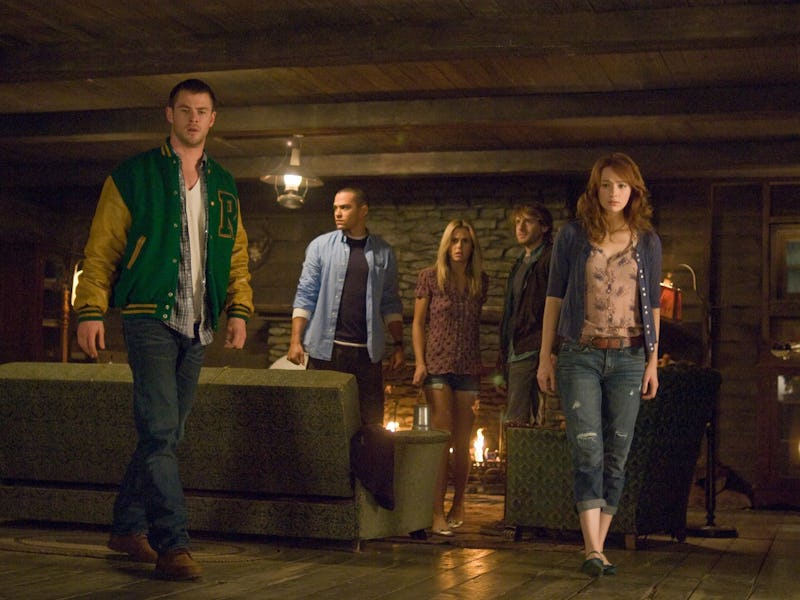Fan Theory 101: Chris Hemsworth's a Villain In 'The Cabin in the Woods'
The jock did it.

The examination of popular culture is no longer a pursuit reserved for academics. Fan theories spring up across the internet every week. Anyone can toss out an idea about the hidden meaning behind a recurring prop in a TV show or a seemingly insignificant character stenciled into the background of comic book panels. It doesn’t matter if there are letters after your name as long as you put forth a compelling argument that taps into an unexplored idea. Some theories thrive and others take a nosedive upon closer inspection. Let’s see which ones stand up.
What if every single horror movie was part of a greater plan? That’s the question Cabin In The Woods answers. The brainchild of Drew Goddard and Joss Whedon spun a new take on a series of old exhausted horror tropes. Villains recycled throughout the genre — to name but three; zombie rednecks, scary Japanese girls, killer ghosts — serve a purpose here. To slay a group of stereotyped teens as an offering to the Ancient Ones, who vow to remain dormant providing they are satiated with a ritualistic killing that concludes with the bloodletting of a virgin. This entire scheme is orchestrated by a government sector at the Facility who coerce the kids into acting out specific behaviors to appease these malevolent old bastards. But what if one of those youngsters was in on it too?
Even though Chris Hemsworth’s ‘jock’ Curt Vaughan dies a spectacular death when his motorcycle smashes into an invisible wall, one Redditor NinjaBreadMan00 supposes that he was targeted by the Facility to grease the wheels and lure the group to the cabin. NinjaBreadMan00 suggests that the whole thing starts with Curt, who tells his friends that his cousin is lending them his shack for the weekend, a statement later questioned by Marty who says that Curt doesn’t even have a cousin. It’s not out of the question that this little white lie was the first step in the Facility’s plan, who rely on drugging the kids to prompt their actions. And yet, something needed to kickstart this series of events:
“The facility needed someone to instigate the sacrifices and nobody else to actually go to the cabin, the easiest way to do this would be to have the person suggesting it be aware of who needs to go. Curt both suggests it and seems to be the only one to have a connection to everybody that is there.”
Fair play. That’s an angle previously unexplored in the movie, and so pinning everything on Curt holds up. Out of the entire checklist of evidence, this is the strongest. Curt dictates the group’s actions during the opening act, including their obligatory meeting with Mordecai, the creepy gas station attendant. It’s here that the theory starts to wobble, with the idea that Curt’s eagerness to get them to the cabin is evident in his flustered response to the attendant. Instead of defending Jules, his girlfriend, he throws money at the old guy and hurries them to move on. His reaction “makes them continue instead of causing a conflict that would keep them there.” But, they have to meet the haggard chap, right? Another part of the ritual.
Much like the way the gang scour the basement for totems. Whoever picks one up and activates it is the one who determines the villains released for ‘the summoning.’ Curt’s decision to grab two objects is explained via incoherent reasoning: he’d take two because he “was either looking for a specific item or apprehensive about what it would cause to happen.” This isn’t a plausible supposition, it’s just attempting to decipher the inner thoughts of a character! Similarly the next piece of the puzzle doesn’t infer anything we don’t already know: Curt leads his girlfriend outside for sex so she can get killed. That’s a part of the Facility’s tampering, heightening arousal through the concoctions pumped into the cabin. Every member of the group behaves in ways to suit their designated archetype.
As he drives the RV toward the escape tunnel, he could have of course driven a lot slower than possible to allow the Facility enough time to block it. Which leads to his sacrificial canyon leap, another key requirement for him to live up to what the Facility promised him (more on that later). The theory flops here, again. He intentionally chugs along slowly so as to endanger not just his friends, but himself? There’s only one dirt bike so just Curt could escape? But he doesn’t escape, no-one does. Everyone dies.
If none of this adds up, it’s because the theoriser underlines the precarious parts of Curt’s scheme with an even dodgier conclusion. What ties this all together is motivation. Why would he agree to the whole deal, especially since his death is part of the Facility’s design? Because he wanted to go out in a blaze of glory. If he were told beforehand that he was “the hero” archetype — and not “the athlete” — then his grand motivational speech right before he rode into that invisible wall was simply him fulfilling a predetermined gesture demanded by “the hero” role. “He was simple [sic] lied to about his role and given an escape strategy that was designed to actually sacrifice him in a manner befitting his true role, so he wouldn’t tell the others the truth.”
The bulk of this theory relies on the same ambition as the movie itself. Audiences who’ve seen it all before and want a new approach. Was Curt an instrument used by the Facility? Yes. But so were the rest of the group.